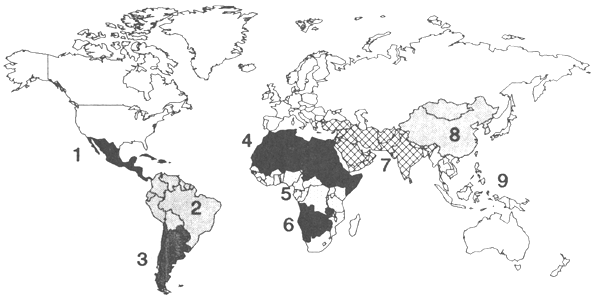The helminth database used in this report was compiled by searching the files of AGRIS, AGRICOLA, CAB and MEDLINE with an online connection to the host organization DIALOG in the USA.
AGRIS is an international information system for the agricultural sciences and technology. The file corresponds to a large extend to the printed publication AGRINDEX of the FAO. The database contains data from 1975 to the present.
AGRICOLA (AGRICultural Online Access) is an extensive bibliographic database mainly of the National Agricultural Library (NAL) USA. It is used to create the printed Bibliography of Agriculture, CD-ROM versions and other NAL products. The database contains data from 1970 to the present.
CAB is the database of the UK Commonwealth Agricultural Bureaux. It is the “summing up” of the data from the more than 30 abstracting journals published by CAB, including such significant titles as e.g. Helminthological Abstracts, Veterinary Bulletin, Index Veterinarius. Abstracts form a major part of the database. The database contains data from 1972 to the present.
MEDLINE (MEDLARS onLINE) is produced by the US National Library of Medicine and is one of the major sources for biomedical literature worldwide. The animal/veterinary part of the file is only minor compared to the medical part. The database contains data from 1966 to the present,
These four databases contain more than 10 million records. The basic material for the Helminth database was collected by the Documentary Service of the Agricultural University of The Netherlands by downloading the search results. The DIALOG option which makes it possible to remove duplicates was used. However, the expected condensation of the working file was not accomplished due to technical difficulties. As a consequence a working file of over 8000 records was created, which was transferred into one INMAGIC file using HEADFORM software. This file contains the essential data for each reference entered consisting of: an identity number, bibliographical data, keywords and abstracts (only from CAB and MEDLINE).
The datafile consists of nearly 18 million characters and loading/indexing the file to a 386S Compaq 84 MB computer using INMAGIC took nearly 100 hours. The strength of the INMAGIC software made it possible to search and combine results within the database in seconds. Using the new version 7.2 of INMAGIC irrelevant records from the created database were eliminated except for a very few. The keywords used in the original search in DIALOG consisted of a combination of parasitic and geographical terms. By manipulation of the data subsets were created using combinations of countries/regions and a variety of animal host species (e.g. bovines, swine, ovines, caprines, horses, poultry). These selections are available as f.i. ETHICOW, concerning all helminth/ cattle information from Ethiopia or SENALL, the subset combining all helminth/host information from Senegal. In order to avoid that the importance of certain less common or very localized host animals were neglected the complete database was searched. This resulted in subsets such as CAMELALL, which contains all information with regard to camels, or DUCKALL, which include all references on ducks.
The printouts were analysed and the most relevant references were selected and about 1500 of them were ultimately included in the annex of this report. The identification number of each reference is used in the report and refers back to the bibliographic information in the annex.
For every country significant details were annotated in a three-page
standard table.
The animal hosts were listed on the vertical axis and the major parasite
groups on the horizontal. In order to facilitate comparisons and analysis
the number of empty cells were reduced by grouping countries into regions.
The regionalization is shown in figure 1. The nine regions correspond
approximately to Köppens classification of climatic zones.
The available information on the Trematodes and Cestodes is presented according to continents and regions where the information was generated. The information on Nematode infections has for practical reasons been presented according to host-parasite combination. A similar approach has been followed for the presentation of the information on helminths in poultry.
The numerical distribution of the references in the data subsets of the database according to region can be seen in table 1. In this report the maps are limited to those parasites or parasite/host combinations that accentuate the text. Question marks indicate areas with very limited information.
The 40 Annexes have been arranged according a combination of the three continents in which the developing countries are situated: America, Africa and Asia and the major parasite groups. Thus in Annex 2. all references concerning schistosomal infections (blood flukes, BF) in Africa are listed under AFRICBF (Africa/Blood flukes) and arranged according to their identification number.
TABLE 1. Number of relevant citations in FAO-database
PARASITE GROUPS
| REGIO | Trem | Cest | Nem | Total |
| AMERICA | ||||
| 1 | 34 | 18 | 48 | 100 |
| 2 | 25 | 25 | 57 | 107 |
| 3 | 10 | 21 | 27 | 58 |
| AFRICA | ||||
| 4 | 53 | 47 | 62 | 162 |
| 5 | 49 | 29 | 73 | 151 |
| 6 | 9 | 9 | 15 | 33 |
| ASIA | ||||
| 7 | 128 | 85 | 166 | 379 |
| 8 | 33 | 15 | 36 | 84 |
| 9 | 30 | 26 | 64 | 120 |
| TOTAL | 371 | 275 | 548 | 1194 |
Fig. 1 Regions: FAO-helminth database developing countries

1. Central America and Caribbean
2. Equatorial America
3. Southern Latin America
4. Northern Africa
5. Equatorial Africa
6. Southern Africa
7. South West Asia and India
8. Central East Asia
9. South East Asia